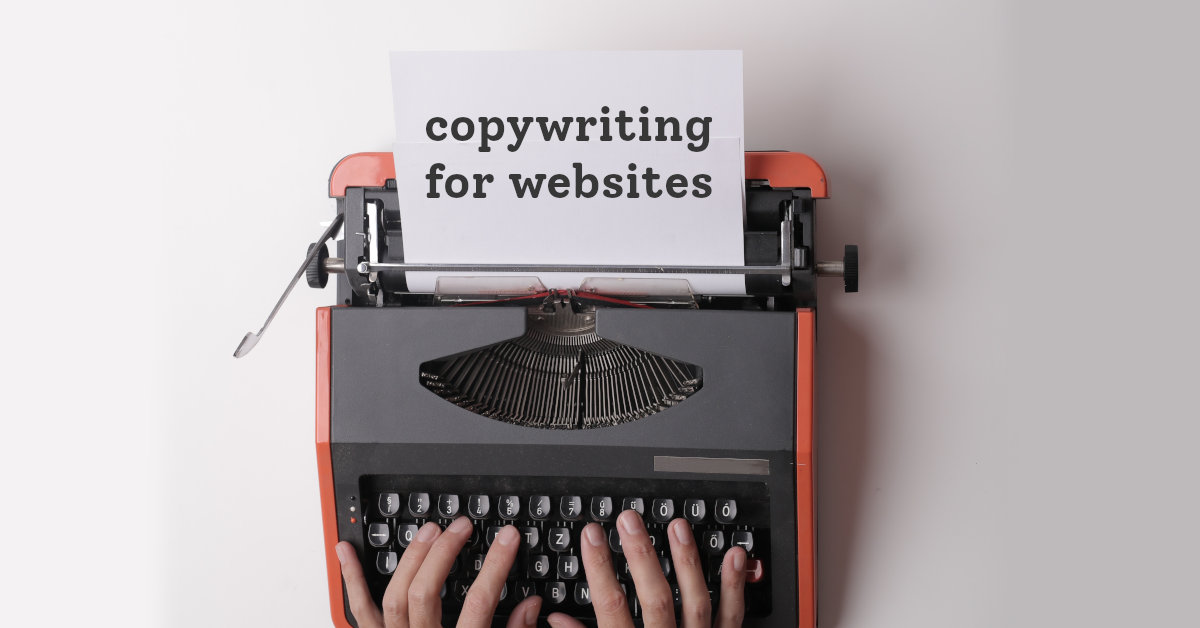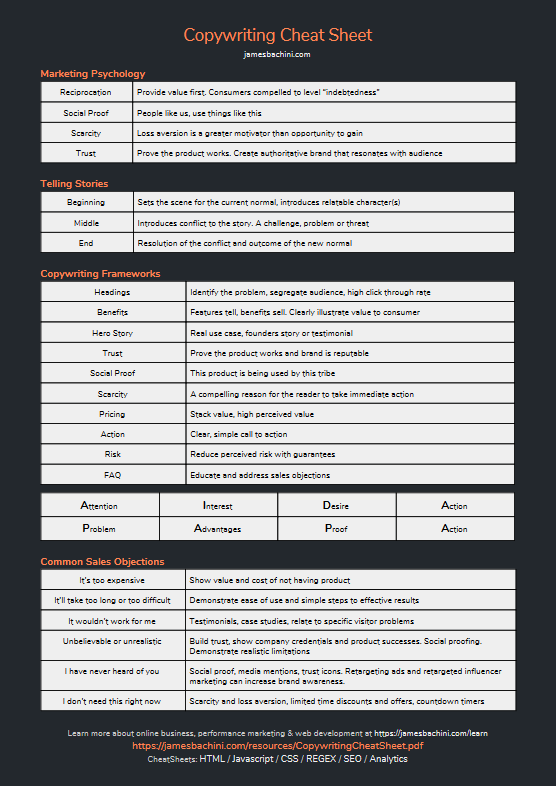This article is part of a free online course where you can learn digital marketing.
This article provides original research on how copywriting for websites converts visitors to customers and how to write better sales copy on your next website or landing page.
- 32 Copywriting Tricks Learned From Analysing 210 Landing Pages
- Marketing Psychology Concepts
- Pressure Points
- Telling A Story With Narratives
- Write For The Ideal Customer
- Overcoming Objections
- Copywriting Frameworks
- Edit Like Pareto
- Learn From Continuous Improvement
- 9 Copywriting Tips For Websites
32 Copywriting Tricks Learned From Analysing 210 Website Landing Pages
In this video I review the takeaways after analysing the top Clickbank landing pages from each category to see what is working right now on the web.

To continue this research let’s look at how marketing psychology affects conversion rates.
Marketing Psychology Concepts
The four most important psychological concepts for marketers to understand are:
These form the core emotional triggers that are built upon to improve conversion rates in sales copy.
Reciprocation

The reciprocity principle is the feeling of indebtedness that we as consumers carry when someone has contributed more to a relationship or situation than ourselves.
For example when someone buys you a present but you didn’t get them anything in return you feel indebted and compelled to balance the situation with a contribution.
This is used a lot in marketing situations where content, products and services are offered free in the hope that consumers will recognise the benefits and go on to make a purchase.
In sales corporate events, gifts, samples and free lunches are all justified in the name of reciprocation.
On the web we use lead magnets in return for an email address such as free:
- eBooks
- Articles
- Webinars
- Video Series
- Resources
- Tools and web apps
- Software Trials
This allows us to send marketing correspondence by email but also enables the marketer to add value before the customer has made any purchase.
Social Proof

Most people associate with a tribe. It might be fans of a particular football club, a profession, a hobby or a cult like following of a particular musician.
We subconsciously imitate role models within that tribe. This causes us to dress the same, consume the same and adjust towards a middling ground.
We essentially become what we associate with in a gradual evolution of our self-image.
Marketers can use this principle to create consumer confidence in products and services. Displaying social validation of a product creates a feeling of “everyone is using this, why aren’t I?”
Online marketers can do this in a number of ways:-
- Testimonials
- Reviews
- Influencer marketing, celebrity endorsement
- Social media accounts
- Stating the number of customers or clients
- Industry awards
- Webinars
- Community forums, chat rooms (Discord/Telegram)
Social proof is most effective when it comes from someone we can resonate with or from a large number of sources. Ideally we want the wisdom of the crowd and the crowd to be full of people like us.
Scarcity / Loss Aversion

Consumers are compelled to take action more if they face losing something than they do to gain something.
In a study by Kahneman and Tversky the loss aversion effect makes the pain of losing $100 twice as big as the pleasure of gaining $100.
This is widely used in marketing, especially to increase the performance of direct response marketing campaigns.
A sales landing page wouldn’t look right without some form of “limited time offer”, “closes at midnight”, “Flash sale 50% off”, “Last chance for early bird pricing”
By creating a limited time frame it flips the buying decision from gaining a purchase to losing an offer.
Countdown timers work great to increase conversion rates when the deadline is less than one sleep away.
Gradual price ladders are very effective for selling conference and event tickets where the price increases daily, weekly, monthly etc.
Scarcity can also be used to increase perceived value. A “limited production run of 10 handmade special editions” for example.
Building Trust

When a new brand is launched it effectively starts at a zero trust rating. This is why aged brands are so valuable.
The more communications from a brand we see and the more we resonate with the marketing communications; the more confidence we have in that company.
Over time a brand can build consumer trust to a level where their products are easier to sell because the consumer already believes in their effectiveness.
Content marketing and social media strategy can be very effective and communicating a message to consumers over a long period of time building trust along the way.
Retargeting ads can take this to the next level to increase outreach of each “post”.
The end goal is to make the brand synonymous with the service. Classic examples include Google for search engines, hoover for vacuum cleaners and most recently Zoom for video calls.
This all relies on a long-term marketing plan. When a direct response is required there are still on-page things we can do to build trust.
- Listing prominent industry clients
- Adding security icons and badges
- Providing success stats
- Offer guarantees
- Show “featured on..” logos
- Case studies and testimonials
- Linking to social media accounts
- Consistent brand image
- Adding credit card logos to payment page
- Show online ratings, links to trustpilot
- Rich media such as video
- Team, office photos
- Transparency
- Value adding lead magnets
- Live chat/support
- Environmental badges/policy
Pressure Points

Pressure points are like marketing one liners that cut through the noise and push buttons.
They take a potential client from not understanding what is in it for them, to getting the concept and recognising the value.
When talking to customers at what point did they “get it” and what was said to enable that? In the past I’ve kept pressure point documents where I’ve kept note of the key things that resonated with customers.
Multivariate testing is a great way to find the best pressure points. Change headings, sub-headings and bullet points to find the points that make the most difference to conversion rate. These are the pressure points to focus on.
Once we have a few one liners that are proven to connect and engage an audience we can use these throughout our marketing communications in banners, emails, landers etc.
Some examples of pressure points from the financial sector.
| Product | Pressure point |
|---|---|
| Paypal | Send money like we do emails |
| Revolut | Don’t get ripped of with bank exchange rate fees |
| Ethereum | Money you can code with |
Of course all the above products do much more than this. But these sentences or variations are often what got people initially interested in their products.
A product should have one core value proposition which should address the most important pressure point.
Telling A Story With Narratives
Narratives are very powerful in marketing and can cement a brand in a consumers mind.
One of my favourites currently is Elon Musk’s Mars Mission. The narrative goes that Tesla and SpaceX are stepping stones on his ultimate goal. To colonise Mars for the sake of humankind. Who doesn’t want to buy a Tesla to support that?
There are countless startups that tell a story about them being the “AirBnB for doing X, with AI… on the blockchain”. Financial markets go crazy when social media starts trending about “The next Tesla” or the “The ethereum killer”.
Narratives are very important and as marketers we have the opportunity to tell our story.
Storytelling Basics

Understanding these two principles will help tell better stories.
- A story needs to be entertaining or educational.
- A story needs a beginning, conflict in the middle and a resolution at the end.
The beginning sets out the normal, the current situation and environment in which the story is set. If a reader can associate with a character, the story will be more powerful.
The middle introduces conflict. Conflict can be a challenge, a problem to solve or a threat.
The end resolves the conflict and describes the new normal.
Stories tend to follow one of a few simple frameworks such as:-
- The hero’s journey – A trip or quest in which the lead character is called into action and eventually evolves or learns something along the way.
- Rags to riches – A transformation where the character went from being fat to losing 100lbs when they discovered…
- Comedy – an unexpected or humorous event that disrupted the normal flow.
Well told stories stick in our minds forever which makes them very powerful for building brands.
Write For The Ideal Customer

For copywriting to be effective the reader needs to feel directly engaged, as if this content was written specifically for them to solve their specific problem.
If the ideal customer isn’t clear then a useful exercise is to map out an analysis using the marketing strategy template and visualise someone who fits.
| Demographic | Age, sex, parent, house owner, apple vs android, type of car |
| Location | Market location, city vs suburbs |
| Work/Role | What is the buyers job role, industry, corporate self image |
| Interests | Does the customer have a specific affinity to any hobbies, interests, genres? |
| Social Media Activity | Different social networks have different demographics. Is your customer more likely to spend time on pinterest or twitch? |
English KISS (Keep it simple, stupid!)
Basic principles still apply that content should be simple and easy to understand. Not everyone that reads the content will speak English as a first language. Short sentences, short paragraphs and simple words.
Overcoming Sales Objections

The best way to find specific objections and problems is to speak to customers and get feedback from lost leads.
A Frequently Asked Questions section is a great way to present objection counters. “It’s too expensive” could be converted to “Are discounts available?” in a FAQ which could then be answered with a short section explaining how much value the product offers and why no discounts or further discounts are available.
Common sales objections and counter content
| Objection | Counter |
|---|---|
| It’s too expensive | Show value and cost of not having product |
| It’ll take too long or it’s too difficult/complex/confusing | Demonstrate ease of use and simple steps to effective results |
| It wouldn’t work for me | Testimonials, case studies, relate to specific visitor problems |
| Unbelievable or unrealistic | Build trust, show company credentials and product successes. Social proofing. Demonstrate realistic limitations |
| I have never heard of you | Social proof, media mentions, trust icons. Retargeting ads and retargeted influencer marketing can increase brand awareness. |
| I don’t need this right now | Scarcity and loss aversion, limited time discounts and offers, countdown timers |
Copywriting Frameworks
Copywriting frameworks provide a boilerplate or starter template from which to craft sales copy. Two of the most used are AIDA and PAPA which we will look at first. Afterwards I’ll share my own copywriting framework that I use as a rough guide and reference when planning and creating sales copy.
- AIDA – Attention Interest Desire Action
- PAPA – Problem Advantages Proof Action
- My Copywriting Framework
AIDA – Attention Interest Desire Action
AIDA is the most commonly used framework for sales copy. Content is created in series with the goal of carrying the reader through the stages to ultimately take action.
| Attention | Capture audience attention. A great ad or headline will get initial interest and a hook, sub-heading or intro will provide a compelling reason to continue reading. At this stage the customer becomes aware of the product or brand. |
| Interest | The copy moves on to generate interest in the product. Interest is like a bell curve. When a consumer knows nothing about a product they have zero interest in the content. When they know everything about a product they have zero interest in the content. Between these two points interest levels ramp up and then drop off. At this stage the benefits (not features) of the product should be highlighted. |
| Desire | The next stage is to create desire for the product. Content should trigger emotional wants or needs. Social proofing, product imagery, how the product fits in with consumer lifestyle. At the stage the reader should reach an emotional tipping point where they want the product. |
| Action | A clear call to action enables the reader to fulfil the desire for the product. At this stage the visitor may convert directly to becoming a customer. Alternatively it may be the completion of a next step action such as downloading a lead magnet or contacting the sales team. |
At each stage of the process there will be a drop off like any conversion funnel.
PAPA – Problem Advantages Proof Action
The PAPA framework is simple, effective and widely used throughout marketing. It’s not as widely known as AIDA but is a more direct match to direct response marketing.
| Problem | The first step is to highlight and resonate a problem. What is the problem that this product solves? Segment and capture an audience by identifying this. |
| Advantages | The second step is to show the solution. What is the advantage of the product to the consumer. How does it solve the problem? |
| Proof | The third step is to prove the product works. This is what makes this framework so interesting. By focusing on proving the product we can eliminate barriers to sales. If the customer believes the product will solve their problem and the price point is right then sales should flow. |
| Action | The final stage is a call to action. |
My Copywriting Framework
This is the latest reiteration of my own framework for creating sales landing pages. I don’t use this as a strict format but refer back to it whenever writing sales copy to use as a reference.
| Headings | The headline should combine a high click through rate with clearly identifying what problem the product solves. The subheading or tagline should lead on from this to portray what the brand is about. The headings should connect with audience to make them feel the content is written for them by someone like them. Shocking headlines are popular because they capture interest and get the visitor to start consuming content. |
| Benefits | Benefits not features can be listed as bullet points or in short skimable text. The core value proposition should be outlined first. Make it clear how the product solves the customer’s pain point. |
| Hero Story | A hero story describes the product and how it was used to solve the issue in a real world case. This could be in the form of a founders story i.e. I created this product when… or in the form of a case study, testimonial or influencer story. The hero story should address the most important sales objections. Often these are how long the product takes to work and how simple it is to use. An image of the product being used often works well and is known as the hero image. Enable the visitor to imagine themselves using the product. |
| Trust | Why should the customer trust your website/brand? Prove the product works, the company is reputable and the customer will be satisfied. Credibility can be emphasised through brand associations, product reviews, specific statistics and industry awards. |
| Social Proof | This is closely connected to building trust but deserves a section of it’s own because it’s critical. The text should convey that people like us use products like these. Ideally the content should be created by “one of us” who understands first hand the problem. It should then go on to show that “many of us” are solving this problem using the product. Social proof creates a keeping up with the Jones effect where the consumer feels tension through being left out. |
| Scarcity | This section should provide a compelling reason for the visitor to take action right now, today. This may be a limited time offer, a declining stock level or countdown timer. The scarcity factor should add tension only once desire for the product has been created. |
| Pricing | Pricing deserves an article of its own. Basically we need to stack as much value as possible to anchor a high price point achieving maximum perceived value for the product. Pricing information should be obscure enough that the visitor doesn’t see it until they have consumed enough content to appreciate the products value. |
| Action | A clear call to action which makes it simpler to purchase the product than to close the tab and walk away. |
| Risk | Minimise perceived risk through guarantees and returns policies. Credibility is key as a guarantee is only as strong as the brand that stands behind it. |
| FAQ | A FAQ (frequently asked questions) section can be used to educate the visitor about the product while addressing common sales objections. |
This is also available in the Copywriting Cheatsheet PDF.
There we have it with my HBHTSSPARF copywriting formula. Probably wont ever be used in a boardroom discussion but it has been used across multiple verticals and high volume landing pages.
Edit Like Pareto

Long form sales letters have worked for over 70 years. However in today’s modern online environment attention spans have shrunk to the stage where we generally swipe away 15 second videos because the content isn’t good enough to watch the whole thing.
We also have remarketing technologies which means marketers have more power than ever before to reconnect with visitors and build trust over an extended period of time.
For this reason I think it’s important to edit aggressively. Sales content should be concise and every sentence should have purpose. The content can still be long-form but it needs to engage the reader and prevent distraction, boredom or disinterest.
Fluff and anything which doesn’t add value to the customer journey should be cut.
The final piece should flow smoothly as over-editing can make text choppy and hard to read. The reader should still be able to get lost in the piece if they are reading every word. Casual readers should be able to skim the content and still takeaway the most important parts of each section.
Learn From Continuous Improvement

Copywriting is a performance marketer’s dream to work with. We can MV test different sections and use events to track where readers are dropping off.
MV testing is a form of conversion rate optimization where we multivariate test multiple factors on the same page. So for example we could write two headlines, then two different benefits sections, to determine the best combinations.
This can be taken to the extreme in a long-form sales copy where there is opportunity to test variations of so much content.
Heatmaps, scroll events and checks to see if a section is visible in the browser can be used to map out the visitor’s journey through the content. We can use this data to find out which sections are underperforming and where focus should be placed on improving.
Code To Fire A Pixel On Section View
The following Javascript code uses an onScroll event and getBoundingClientRect() function to check if an element is in view on the screen. This will then add a tracking pixel with the section ID added to the pixels div to record the data on an external tracker.
Copywriting is often seen as a mysterious art and a lot of what we know was written in the previous century. Books by Whitman, Ogilvy and Halbert are still hugely popular and get regurgitated across the web.
The psychological principles are constant and haven’t changed but the mediums in which we use to communicate have. Online media is constantly evolving and continuous testing not only drives performance but educates the writer and provides insights on what works now.
We have more feedback loops than ever before enabling modern marketers to learn faster, optimize quicker and take copywriting to the next level. Much like a 1960’s athlete isn’t competitive by today’s standards, the best copywriters have developed their own techniques and philosophies that work in the modern age of the web.
9 Copywriting Tips For Websites
- Plan content using a copywriting framework and build out each section to ensure a structured proven format.
- Write for the ideal customer as a member of their associated tribe.
- Take a look at clickbank products for inspiration on what is working and how to format content.
- Features tell, benefits sell. Write for the customer and describe how the product benefits them.
- Tell stories with a beginning, middle and end providing a resolution of conflict. In business formats this can be achieved through founders stories and case studies.
- Including psychological triggers such as reciprocation, social proof, scarcity, trust can increase engagement
- Track each section’s scroll to rate to find out where readers are dropping off and MV test variations to continuously improve performance.
- Edit aggressively to ensure the content is simple, concise and contains a clear call to action.
- Download the Copywriting Cheatsheet PDF and refer to it for reference when creating sales copy
This article is part of a free online course where you can learn digital marketing.
If you’ve enjoyed these resources could you help share this content on social media and send it to anyone who you think might benefit from it.
Thank you.




